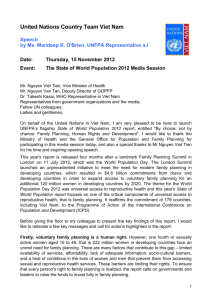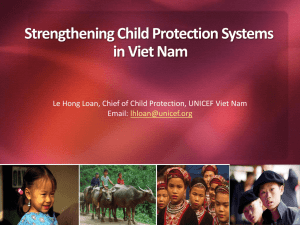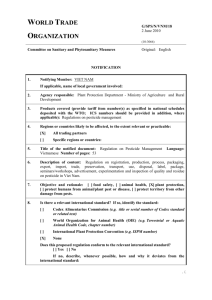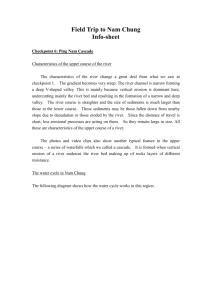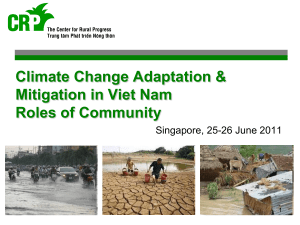Early ART
advertisement
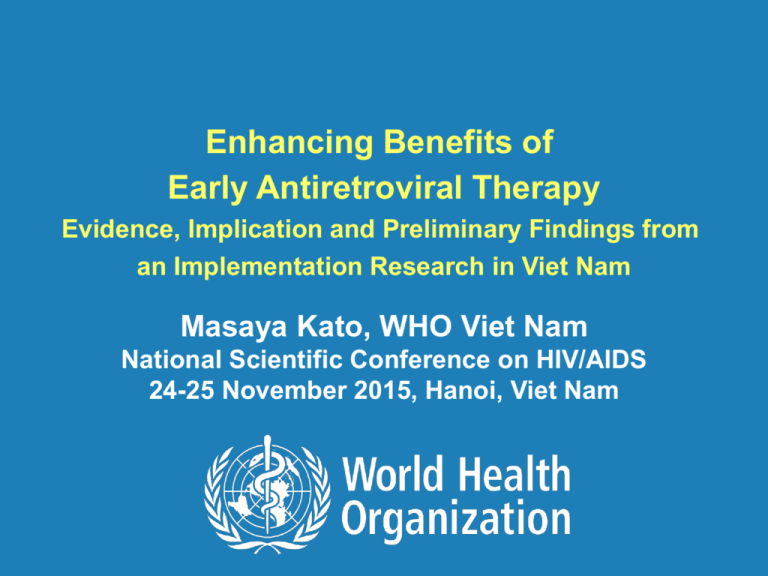
Enhancing Benefits of Early Antiretroviral Therapy Evidence, Implication and Preliminary Findings from an Implementation Research in Viet Nam Masaya Kato, WHO Viet Nam National Scientific Conference on HIV/AIDS 24-25 November 2015, Hanoi, Viet Nam World Health Organization | Viet Nam Country Office 1 Early ART – Evidence of Therapeutic Benefits - Two large randomized controlled trials Sample size TEMPERANO START 2056 4651 CD4 inclusion criteria • Immediate ART • Deferred ART CD4<800 • Immediate start • CD4<250, 350, 500 CD4>500 • Immediate start • CD4<350 Primary outcomes • Death or severe HIVrelated illness • Composite end point: Serious AIDS & nonAIDS events, deaths, TB, etc Hazard ratio of primary outcomes World Health Organization | Viet Nam Country Office 0.56 (0.41-0.76) 0.43 (0.30-0.62) 2 Early ART – Evidence of Preventive Benefits - HPTN052 – RCT among serodiscordant partners Linked transmission 50 40 30 43 93% reduction • • • 20 10 3 0 Delayed ART Early ART • Early ART (CD4 350-550) vs delayed ART (CD4<250) in index partners 93% decrease in linked infections Only 8 cases of transmission when index partner was on ART o 4 diagnosed shortly after ART start → Likely before viral suppression o 4 occurred while treatment failure No transmissions when viral load undetectable N = 1761 3 World Health Organization | Viet Nam Country Office 3 WHO - When to Start in Adults: Evidence summary • • • A systematic review comparing ART initiation at CD4 <500 CD4 vs ≥500 CD4 cells/µL 1 RCT* (TEMPRANO) and 17 cohorts or meta-analyses of cohorts Less severe HIV morbidity, HIV disease progression and HIV transmission, without increase in grade III/IV lab adverse events. WHO 2015 Early Release Guidelines ART should be initiated among all adults with HIV regardless of WHO clinical stage and at any CD4 cell count • As a priority, ART should be initiated among all adults with severe or advanced HIV clinical disease (WHO clinical stage 3 or 4) and adults with CD4 count ≤350 cells/mm3 World Health Organization | Viet Nam Country Office 4 Viet Nam: Findings from Modelling Studies New HIV infection 2013-30 Asian Epidemic Model • Baseline 80% CD4<350 80% CD4<350 + immediate ART for key populations Three modelling studies on potential impact of early ART in Viet Nam: VAAC, WHO, CDC, Can Tho data (JAIDS, 2013. 63(5): e142-9) UNSW, PrevTool (Lancet Global Health, 2014. 2: e23-34) VAAC, Asian Epidemic Model (VAAC) Early diagnosis and immediate ART → significant reduction in HIV transmission and AIDS deaths Highly effective and cost-efficient if high coverage achieved in key populations Initial investment needed, but will leads to high returns World Health Organization | Viet Nam Country Office 5 Implication for Programme Need for Higher Coverage at Cascade Steps Diagnosis Enrolment Viral suppression ART Viet Nam HIV Care Cascade 2014 Number of PLHIV 300,000 250,000 250,060 100% Viral suppression needed for full benefits of ART 171,000 68% 200,000 150,000 100,000 94,693 38% 93,298 37% 86,674 35% Enrolled in OPC On ART Virally suppressed 50,000 0 PLHIV Diagnosed Sources: Estimation by Asian Epidemic Model (PLHIV); Case reporting system (Diagnosed); Routine reporting system Decision 28 (Enrolled in OPC, On ART); Estimated from the results of acquired HIV drug resistance survey (viral suppression) World Health Organization | Viet Nam Country Office 6 Viet Nam: Care Cascade in Key Populations Cascade among PWID using Viet Nam IBBS 2013 data Number of PWID 1000 800 Large gap 600 400 200 0 HIV+ Diagnosed Enrolled in care ART started Still on ART Earlier diagnosis and improved cascade in key populations critical to achieve benefits of early ART World Health Organization | Viet Nam Country Office 7 Translating Evidence into Programme - Operational Questions • Feasibility and acceptability in Viet Nam programme Earlier diagnosis and immediate ART Especially among key populations • Adherence, retention and viral suppression Among those starting ART with higher CD4 count • Possible behavioral disinhibition (risk compensation) after ART initiation • ARV toxicity especially among people with high CD4 count • Hence, an implementation research study to inform implementation of early ART in Vietnam World Health Organization | Viet Nam Country Office 8 Implementation Research Viet Nam HIV Testing and Early ART (V-HEART) By VAAC, HMU, NIHE, WHO • Objective To assess the operational feasibility and acceptability of periodic voluntary HIV testing among PWID, and immediate ART irrespective of CD4 count among HIV+ PWID in Viet Nam’s programme. • Outcome indicators (selected) Viral suppression at 6 and 12 months after ART start Retention across the care cascade Self-reported risk behaviours Qualitative analysis of feasibility and acceptability (not shown in this presentation) • Study ongoing: Interim results shown in this presentation World Health Organization | Viet Nam Country Office 9 Methods Study setting and interventions • Since April 2014, in Thai Nguyen and Thanh Hoa provinces: – HIV testing every 6 month recommended to PWID, and – Immediate ART (irrespective of CD4 count) offered to PWID diagnosed HIV+ – Counselling promoting concomitant use of other prevention methods – Following consent after informed on benefits and risks of immediate ART Participants • PWID defined as an individual: – who self-reported injecting drugs within 30 days; or – who self-reported ever injecting drugs and had a visible injection site; or – on MMT Assessments & Procedures • HIV viral load (VL) assessed before ART start (baseline), at months 6 and 12 • Behaviours assessed at baseline, at months 3, 6, and 12. World Health Organization | Viet Nam Country Office 10 Participant Baseline Characteristics Interim analysis based on 251 individuals who started ART by December 2014 CD4 ≤ 350 CD4 > 350 Overall N = 163 N = 88 N = 251 98.2% 98.9% 98.4% 34 (30-39) 36 (30-39) 34 (30-39) 80.4% 86.4% 82.5% 97 (31-204) 478 (402-632) 208 (55-402) 112,201 (43,651 – 257,039) 16,595 (5,754 – 47,863) 63,095 (15,848-169,824) Sex % Male Age (Years) Median (IQR) Education % Secondary school and above CD4 baseline Median (IQR) Viral load baseline (copies/ml) Median (IQR) World Health Organization | Viet Nam Country Office 11 Retention on ART (by baseline CD4 count) Baseline CD4 count Retention high in the first 6 month of ART, especially those starting ART at CD4>350 World Health Organization | Viet Nam Country Office 12 Viral suppression at Month 6 %VL< 1000 copies/ml 100% 80% 89% CD4 ≤ 350 CD4 > 350 86% 60% 40% 20% 0% 14% 4% Month 0 (ART start) Month 6 N (CD4 ≤ 350) 168 120 N (CD4 > 350) 88 72 At month 6, >85% achieved viral suppression (<1000 copies/ml) irrespective of CD4 count World Health Organization | Viet Nam Country Office 13 Self-reported Risk Behaviors % Clean needle use in the last injection among those reporting injection drug use in the past 1 month % Consistent condom use in the past 3 months among those reporting ongoing sex partners 100% % Consistent condom use % Clean needle use 90% 80% 70% 60% 50% 40% 30% 20% 10% 0% Month 0 Month 3 Month 6 100% 90% 80% 70% 60% 50% 40% 30% 20% 10% 0% Month 0 Month 3 Month 6 No increase in risk behaviours observed in the first 6 months World Health Organization | Viet Nam Country Office 14 Summary • Strong evidence supporting benefits of early ART Prevents morbidity, mortality and transmission WHO recommends ART initiation at any CD4 cell count • Programmatic Implications of early ART Earlier diagnosis and improved cascade in key populations critical Cost-effective, and investment likely leads to high return • Implementation research interim analysis In early phase of ART, high retention and viral suppression achieved among PWID starting ART at the higher CD4 count Comprehensive analysis to inform programming of early ART World Health Organization | Viet Nam Country Office 15 Acknowledgement • • V-HEART study participants • Health care workers at study sites • • Community collaborators, peer educators Donors: – – – • V-HEART investigators VAAC, MOH MAC AIDS Foundation, Global Fund United Nations in Viet Nam Nathan Ford, Naoko Ishikawa Viet Nam Authority for HIV/AIDS Control • Nguyen Hoang Long • Bui Duc Duong • Nguyen Huu Hai • Do Thi Nhan Hanoi Medical University • Le Minh Giang • Dinh Thi Thanh Thuy • Nguyễn Minh Sang • Truong Van Hai National Institute of Hygien and Epidemiology • Pham Hong Thang • Nguyen Le Hai • Tran Hong Tram World Health Organization | Viet Nam Country Office Thai Nguyen Provincial AIDS Center • Le Ai Kim Anh • Ho Thi Quynh Trang Thanh Hoa Provincial AIDS Center • Nguyen Ba Can • Vu Dinh Nam WHO Viet Nam • Masaya Kato • Nguyen Thi Thuy Van • Vu Quoc Dat • Amitabh Suthar WHO WPRO • Ying-Ru Lo 16
